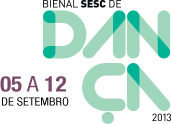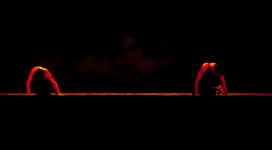blog_ 7x7
João Saldanha x Bruno Freire = Everyone is so contemporary or today I woke up classic
by Bruno Freire on Aventura entre Pássaros by João Saldanha.
I’m not quoting Agamben to talk about the contemporary. The book is always there by the bedside table for reference and for you to quote it at the bar table and make yourself eloquent. Giorgio Agamben is much used to justify a certain speech obscurity and in some way disguising an uncertainty of curating axis. After all, I, the blind one, can’t see the brightness of the darkness only they see. Wait because one day we will know < Never> .
When I leave the Adventure among João Saldanha’s birds, I face the following paradigms: why is there in the air a demand for being ‘contemporary’? What is to fear about the modern thought? Is it possible to develop a modern thought today? Have we ever been modern? Is it really possible to freeze a dance in the 90s? And why does a modern or classic dance need to be considered contemporary? And why don’t we invent other names for different dances?
All Art Has Been Contemporary, 1999, Maurizio Nannucci.
All the arts have been contemporary.
Reenactment is cool. Reenactment is like an ability to do something the way it was done before and what is interesting is that I wasn’t there to see. But this fact in itself doesn’t justify a remake <but yes>. International companies remake their primordial shows in a historical and educational sense too. To inform the following generations that one day there was this and that and that other thing. Making the play a live happening. I can observe its influence, the formal, conceptual and esthetic repercussion in the companies that came later. Who hasn’t seen Wim Vandekeybus’ Dr. Martens replicated in the Cena 11’s shows? <I can’t remember if the boots were the same, but they were very similar.>
However, today an artist who investigates a language that dismantles and reassembles modernist and classic thoughts and techniques may be seen as démodé, old and/or outdated <neoclassic?>.
João Saldanha sets off from the book The Expression of the Emotions in Man and Animals by Charles Darwin mixing it to and revisiting the classic The Swam Lake, which has as one of its features the playful character. A classic of the dance as so many other classics based on narratives and pantomimes.
In the first scene of the show, João seems to create costume designs, like a kind of overview of the clothes worn in different dances of varied times, not in an obvious chronological order though. But it is as if each bird that enters the stage from left to right were making a reference to a dance. The details in the outfits make reference to the jazz era, to Cunningham, to the classic era, to the modern era, to the non-commitment with the improvisation contact, to children’s plays, to bird feathers, etc.
The birds’ moves in the order of the truth, not of the mimetic. The dancers don’t wish to imitate/mime nature, but create another reality/nature on the stage. Oneiric. Poetic. It is not representation, but the creation of codes that are recognizable by the public, and these codes are precisely the ones that make the public follow, if they wish to, the development of a new language that will be worked on and again during the whole show.
I remember Noverre’s letters, in which much was discussed, there in the French court ballet, concepts that were born from codes and practices of an elite whose themes reverberate in dance codes until today. <Evolution, baby> A discussion is going on there, for example, whether art should imitate nature. And the pantomimes, the ballet actions go in this direction, between moving away from imitation or not and/or creating a likeness (a made up reality that creates its own codes and meanings, sharing these codes with the spectator, who learns while watching or the more he/she watches).
João Saldanha invents a dance sometimes using traceable and simple slides for those who have already been in some dance class. But he approaches Darwin to create his pantomimes according to animal movements, mixing the technique to a likeness that comes from the body and nature. This appropriation is literal. It is explicit. It assumes what gestures metaphorically represent. To point the index finger means no. To point the index finger to the public means ‘this is a gun’, but also it isn’t a gun, it’s a frame, but I don’t see a painting, it’s a telephone that is a hang-loose sign too. Parece que as velhas pantomimas estão sendo revistas e revisitadas. To revisit the pantomime from the moves of the most varied birds moving about on stage, frogs, herons, spiders, crabs… It sounds like too much representation. Theater for little kids <but no>. João Saldanha establishes a conversation with his peers in a choreographers’ language. He poetically remakes the evolution of a dance, adding up his own experience and dance story, that of a resident in Rio de Janeiro.
To watch this adventure is to watch the evolution of several dance codes. The birds are an excuse to tell an adventure in dance, literally.
To watch João Saldanha’s work is the difference between observing a conversation and a dialog. A conversation may be with many, a dialog is one to one.
Meantime, there in the stage background, the wind blows the canvas of the boat of a continuous story.
The wind blows.
Where to?
I don’t know.
I’m not that contemporary.
Translation Portuguese-English: writer and poet Chris Ritchie, M.A.

